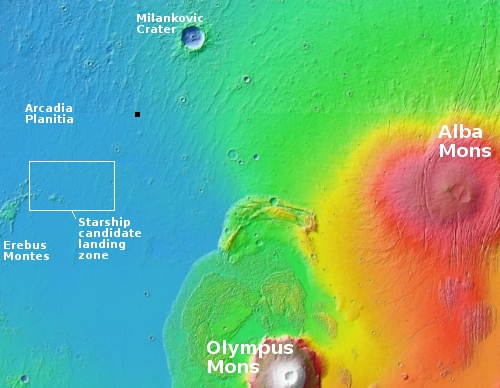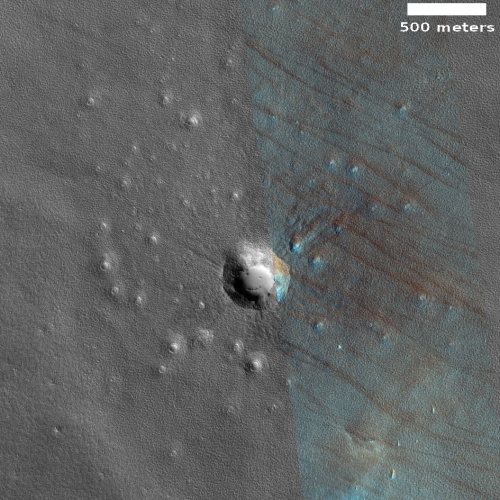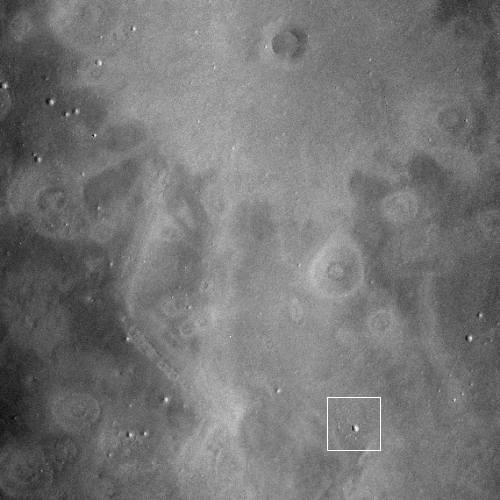A spray of Martian meteorites
Cool image time! The photo to the right, cropped and reduced to post here, was taken on October 26, 2020 by the high resolution camera on Mars Reconnaissance Orbiter (MRO). It is what the camera team calls a “terrain sample,” meaning it was not specifically requested by a researcher but was instead chosen by the camera team because they need to regularly take images to maintain the camera’s temperature. When they do this, they try to pick a location that hasn’t been photographed in high resolution previously, and that might have some interesting features. Sometimes the photo is boring. Sometimes they hit pay dirt.
In this case, the photo captured an small impact crater, about 1,300 feet across, surrounded by a spray of secondary impacts. The color portion of the image shows what I suspect are dust devil tracks cutting across a surface that, because of its blue tint, is either rough or has frost or ice within it. At 48 degrees north latitude, the possibility of the latter is high, especially because this location is northwest of the Erebus mountains, where SpaceX has its prime Starship candidate landing zone and where scientists suspect ice is readily available very close to the surface. The overview map below shows this context.

This crater’s location, indicated by the black box, is also 250 miles southwest of 74-mile-wide Milankovic Crater, where scientists have discovered numerous scarps with almost pure ice layers exposed.
The spray of small secondary impacts surrounding this small crater in the first image above likely came from the central impact. The central impact however could very well be a secondary impact itself, ejecta thrown off by the bolide that smacked into Mars to create Milankovic.
The hypothesis is reinforced by taking a look at the immediately surrounding terrain.
To the right is a wider view, with the white box showing the location of the top image. It was taken by MRO’s context camera. As you can see, this small impact crater is only one of many, scattered across a relatively smooth and flat region interspersed with what look like small volcanoes.
All of the small craters look to be about the same age. Moreover, that there are no large or more eroded craters here suggests that the small volcanoes, which either formed from magma or mud pushing upward, had covered over the older terrain, became inactive, and then the Milankovic impact occurred, showering this region with secondary material.
One last item: Note the nature of the small secondary craters in the first image. All look like the kind of depression you see when you drop a stone into slushy ice. The bright blue color of the material in the secondary craters in the color strip also suggests ice.
This shouldn’t be surprising. At this high latitude, north of what is believed to be a very icy region near the Erebus Mountains, ice should be plentiful, just before the surface.
On Christmas Eve 1968 three Americans became the first humans to visit another world. What they did to celebrate was unexpected and profound, and will be remembered throughout all human history. Genesis: the Story of Apollo 8, Robert Zimmerman's classic history of humanity's first journey to another world, tells that story, and it is now available as both an ebook and an audiobook, both with a foreword by Valerie Anders and a new introduction by Robert Zimmerman.
The print edition can be purchased at Amazon or from any other book seller. If you want an autographed copy the price is $60 for the hardback and $45 for the paperback, plus $8 shipping for each. Go here for purchasing details. The ebook is available everywhere for $5.99 (before discount) at amazon, or direct from my ebook publisher, ebookit. If you buy it from ebookit you don't support the big tech companies and the author gets a bigger cut much sooner.
The audiobook is also available at all these vendors, and is also free with a 30-day trial membership to Audible.
"Not simply about one mission, [Genesis] is also the history of America's quest for the moon... Zimmerman has done a masterful job of tying disparate events together into a solid account of one of America's greatest human triumphs."--San Antonio Express-News
Cool image time! The photo to the right, cropped and reduced to post here, was taken on October 26, 2020 by the high resolution camera on Mars Reconnaissance Orbiter (MRO). It is what the camera team calls a “terrain sample,” meaning it was not specifically requested by a researcher but was instead chosen by the camera team because they need to regularly take images to maintain the camera’s temperature. When they do this, they try to pick a location that hasn’t been photographed in high resolution previously, and that might have some interesting features. Sometimes the photo is boring. Sometimes they hit pay dirt.
In this case, the photo captured an small impact crater, about 1,300 feet across, surrounded by a spray of secondary impacts. The color portion of the image shows what I suspect are dust devil tracks cutting across a surface that, because of its blue tint, is either rough or has frost or ice within it. At 48 degrees north latitude, the possibility of the latter is high, especially because this location is northwest of the Erebus mountains, where SpaceX has its prime Starship candidate landing zone and where scientists suspect ice is readily available very close to the surface. The overview map below shows this context.

This crater’s location, indicated by the black box, is also 250 miles southwest of 74-mile-wide Milankovic Crater, where scientists have discovered numerous scarps with almost pure ice layers exposed.
The spray of small secondary impacts surrounding this small crater in the first image above likely came from the central impact. The central impact however could very well be a secondary impact itself, ejecta thrown off by the bolide that smacked into Mars to create Milankovic.
The hypothesis is reinforced by taking a look at the immediately surrounding terrain.
To the right is a wider view, with the white box showing the location of the top image. It was taken by MRO’s context camera. As you can see, this small impact crater is only one of many, scattered across a relatively smooth and flat region interspersed with what look like small volcanoes.
All of the small craters look to be about the same age. Moreover, that there are no large or more eroded craters here suggests that the small volcanoes, which either formed from magma or mud pushing upward, had covered over the older terrain, became inactive, and then the Milankovic impact occurred, showering this region with secondary material.
One last item: Note the nature of the small secondary craters in the first image. All look like the kind of depression you see when you drop a stone into slushy ice. The bright blue color of the material in the secondary craters in the color strip also suggests ice.
This shouldn’t be surprising. At this high latitude, north of what is believed to be a very icy region near the Erebus Mountains, ice should be plentiful, just before the surface.
On Christmas Eve 1968 three Americans became the first humans to visit another world. What they did to celebrate was unexpected and profound, and will be remembered throughout all human history. Genesis: the Story of Apollo 8, Robert Zimmerman's classic history of humanity's first journey to another world, tells that story, and it is now available as both an ebook and an audiobook, both with a foreword by Valerie Anders and a new introduction by Robert Zimmerman.
The print edition can be purchased at Amazon or from any other book seller. If you want an autographed copy the price is $60 for the hardback and $45 for the paperback, plus $8 shipping for each. Go here for purchasing details. The ebook is available everywhere for $5.99 (before discount) at amazon, or direct from my ebook publisher, ebookit. If you buy it from ebookit you don't support the big tech companies and the author gets a bigger cut much sooner.
The audiobook is also available at all these vendors, and is also free with a 30-day trial membership to Audible.
"Not simply about one mission, [Genesis] is also the history of America's quest for the moon... Zimmerman has done a masterful job of tying disparate events together into a solid account of one of America's greatest human triumphs."--San Antonio Express-News




Did you notice the smiley face in the center of the large impact crater?
@Tom I was going to post the same. I did notice it & seems a bit creepy to me with those sewn lips…